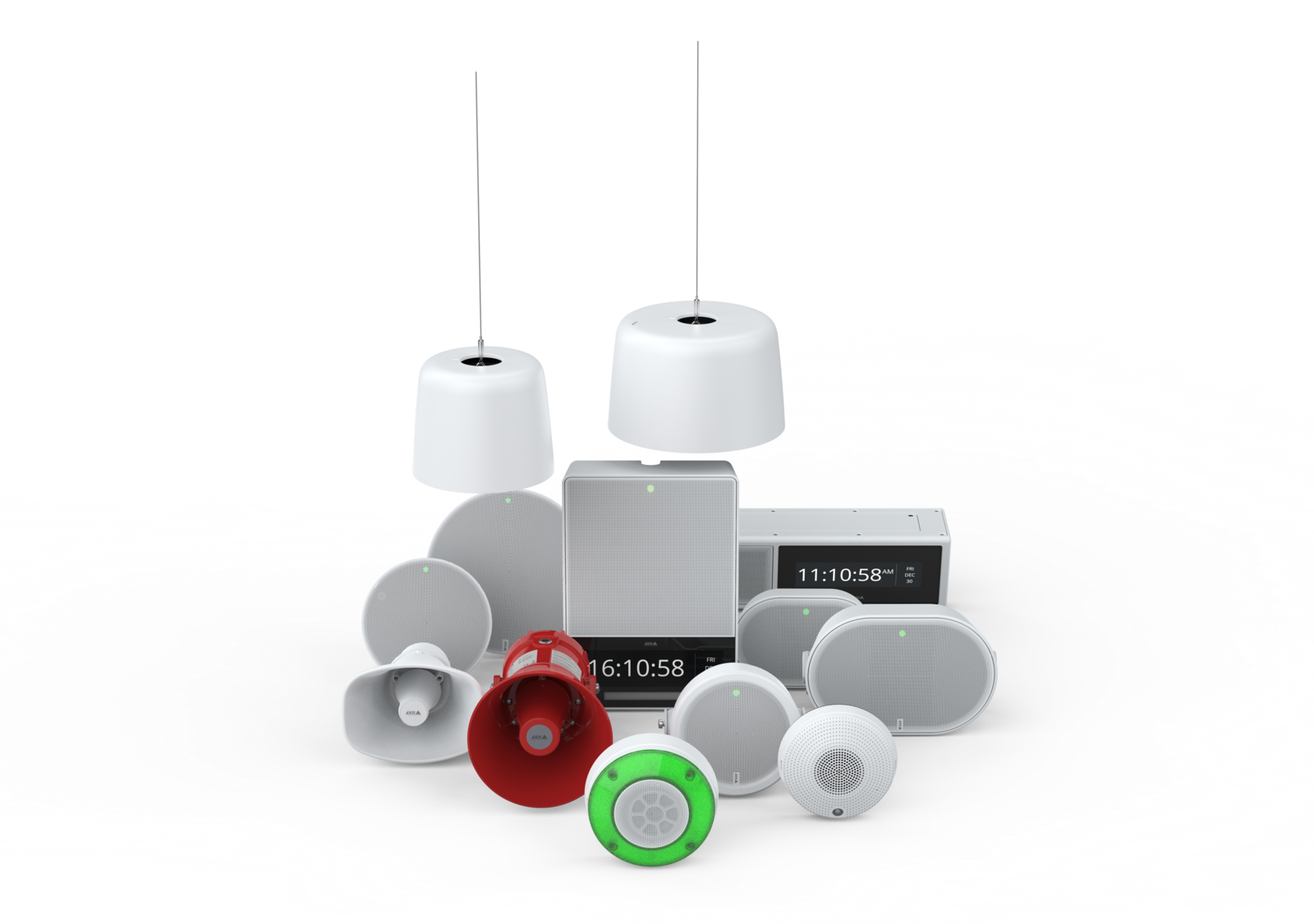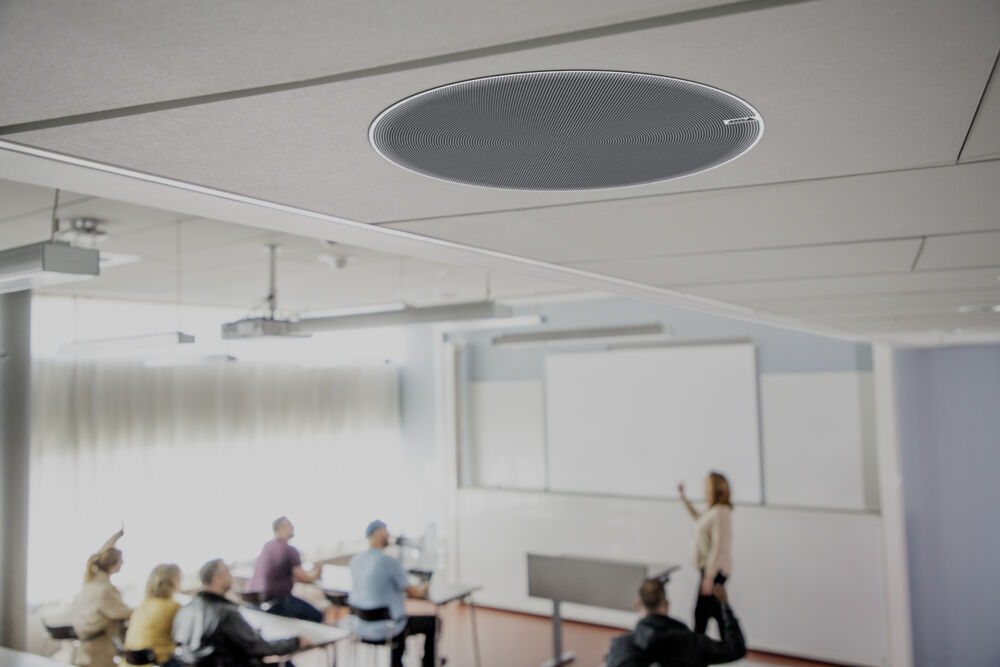Public address
Summary
Public address (PA) systems enable the broadcasting of announcements and can greatly improve security, safety, and operational efficiency in public, institutional, and commercial premises. A PA system can be used to issue live, scheduled, or event-triggered messages, in regular daily operation as well as in an emergency.
If you have many speakers on a site, you can divide the site into zones and play content in one or more zones. In a school, for example, you could make announcements to individual classrooms, several classrooms, or to the whole school.
You can build a flexible, IP-based PA system in several ways using Axis audio products, combining an audio input device with Axis IP speakers and management solutions. Axis audio devices are network-connected, so when you need to add more devices to the system you just plug them into the network and add them in our configuration software.
PA from Axis comes with built-in controls to ensure crystal clear sound quality, device connectivity, and functionality. In an emergency or other unforeseen event, you will know that the PA system is fully functional and ready to provide instantaneous instructions.
Based on IP and open standards, Axis PA is easily integrated with alarm systems, video surveillance, access control, and telephony. This enables automated processes between the systems. Integrated with a third-party system for earthquake detection or other early warnings, the PA system can be used to quickly inform the public. Integrated with video surveillance, it could allow operators to transmit verbal warnings when intruders are detected. The opportunity for integration with third-party systems creates a futureproof PA system where new possibilities and new use cases can always be introduced.
Introduction
Public address (PA) systems enable the broadcasting of announcements in locations such as schools, commercial buildings, and healthcare facilities. Modern IP-based PA systems consist of IP audio devices, typically microphones and speakers, and audio management software which may be integrated in the devices. Announcements can be made live, played back according to a schedule, or triggered in response to specific events.
This white paper provides an overview of how PA systems can be built with Axis network audio products, standard office equipment (such as IP telephones), and standard network cabling. We list the main benefits and features and describe some of the most central use cases of IP-based PA systems. This includes what a PA system can offer, which types of devices to use, and what to think about before deploying the system.
IP-based public address from Axis
Network audio systems offer a single, flexible, scalable, and reliable solution for different kinds of needs, whether for protecting property, keeping people safe, or optimizing a business. The systems are futureproof, easy to use, and have built-in controls to ensure sound quality as well as device connectivity and functionality.
Simple and scalable
With IP-based PA systems, you can use existing network cabling to connect the audio input and audio output devices. When you need to add more devices to the system you just plug them into the network.
This scalability means that you can easily meet changing needs and requirements by expanding or changing the system.
Sound you can trust
All the functionalities are integrated in the active IP speakers. Each speaker includes both hardware and software and is a complete sound system. The digital signal processing is preconfigured to ensure clear and comprehensible voice messages.
All devices can be monitored through the network. Remote health checks keep you informed that the system is working, with the possibility for remote troubleshooting if needed.
These functionalities ensure that the PA system is functional and optimized when needed the most, such as in an emergency or other unforeseen event.
Flexible zones and content
The IP speakers can be grouped in different zones independently of the physical cabling. This means that administration of speaker zones is simple and easy to change. Both zone management and content management are done in the configuration software, which provides flexibility and allows you to broadcast the content you want, in the right location, at the right time.
The remote management means that whenever you need to make changes to zoning or content, there is no need for re-cabling, no downtime, and no need to send staff to physically visit the site.
Integrates with other systems
An important advantage of using an IP-based public address system is the possibility to integrate with other network- and analog-based systems for access control, video surveillance, fire and evacuation alarm, and telephony. The integration allows automated processes.
PA systems integrated with video surveillance help operators issue warnings to intruders detected by the cameras. This is important in perimeter protection because trespassers are often easily deterred if they hear a verbal warning that they’re under surveillance.
Public address from Axis can also be integrated with various third-party mass communication systems. For example, the application AXIS Speaker Functionality for Singlewire InformaCast® makes Axis speakers fully compatible with a Singlewire InformaCast solution and others for emergency alerts, critical event management, visual notification, as well as IP paging.
Integration is possible because IP-based PA systems are built on open standards. This creates a futureproof system where new possibilities and new use cases can always be introduced.
Two-way audio
A PA system from Axis doesn’t have to be a one-way communication system. The speakers have a built-in microphone that allows for two-way hands-free audio talk-back.
With half duplex you can send and receive audio (talk and listen) in one direction at a time, similar to a walkie-talkie conversation. The direction is controlled automatically through voice detection software or manually through a push-to-talk button. There is no risk of echo problems because speaker and microphone are never active at the same time.
With full duplex you can send and receive audio (talk and listen) at the same time, similar to a phone conversation. The speaker uses advanced echo cancellation that prevents feedback and echo by stopping the speaker’s sound from being fed back to the microphone.
Visual alerts
By integrating visual alerts with your PA system, communication can be made more effective, inclusive, and aligned with accessibility standards. Visual indicators are designed to complement audio messages and cater to diverse environments and needs.
Strobe speakers or strobe sirens are especially effective for emphasizing critical messages. LED strobes can be color-coded and programmed to various intensity levels and light patterns, allowing them to convey different types of alerts. Strobes can also provide directional information and, when equipped with a built-in microphone, facilitate hands-free two-way communications, which is especially beneficial in settings like parking garages.
Display speakers combine audio messages, strobe colors, and scrolling text to reach a broader audience. These solutions are particularly effective in schools, healthcare facilities, and transportation hubs. The display and strobe features are customizable, offering various colors and text animations for different scenarios, with the possibility to create static text reminders or silent alerts.
Audio analytics
With Axis audio you can not only broadcast information but also detect and respond to incidents. Sound detection analytics enable our speakers to recognize specific sounds, such as shouting and breaking glass. This can help keep you alert to urgent issues and allow you to respond by playing a prerecorded message or speaking live.
Multipurpose use
A PA system is versatile and suits many types of applications.
Safety
A PA system can be used to issue live or triggered announcements during critical incidents. In a school, for example, you can integrate it with a third-party system for mass communication to make sure that students remain safe, with your critical message overriding all the scheduled audio output. You can also integrate a PA system with a third-party partner system such as earthquake detection or weather alerts, where it is crucial that the public is informed as soon as possible. While it can’t replace a certified fire alarm, a PA system from Axis can complement a fire alarm and broadcast instructions in all relevant zones, saving time and potentially lives.Operational efficiency
In retail environments, the PA system can be used to play recorded or live informative messages, updates, and audio commercials. In schools or production facilities you might want to play bells or signals at specific hours, for example, for breaks. You can use the PA system to call someone to a specific area, such as a colleague to the checkout counter, or a student to the principal’s office. There is also a possibility to play music from a radio station or a commercial provider of music. You can set up priorities so that the music is muted for announcements.Security
By integrating the PA system with video surveillance, you can set the systems up so that video events automatically also trigger audio clips, typically dogs barking or a voice message, to discourage unwelcome individuals.
Components of a public address system
Audio input, audio output, and audio management can all be set up using Axis products and standard IT equipment.
Audio input devices
Many types of devices can be used to provide the audio input: both Axis products and standard IT equipment. The choice of input device affects how zones, content, scheduling, and user access can be managed.
Devices for audio input often use SIP (Session Initiation Protocol), which is the standard communication protocol in the telecommunications and unified communications industry. All Axis audio products are SIP-compatible.
IP microphone as input device
The network paging console from Axis enables both callouts and two-way audio. It provides convenient access to as many audio zones and individual contacts as you choose. You can configure its buttons as you like and play live announcements, trigger audio clips from the onboard memory, and even unlock doors. The console has a built-in speaker and microphone for hands-free communication, with option for adding a headset or gooseneck microphone.
The console allows for two-way audio with intercoms and speakers across your site for more efficient communication. And because the console is built on the Axis open platform, you can also configure the buttons to trigger actions on other IoT devices.
SIP telephone as input device
All office VoIP (Voice over IP) telephones today are SIP-compatible. Any standard SIP telephone can be used to call the SIP address of an Axis IP audio device.
To facilitate daily operation, you can program a button, or a combination of buttons, on the phone to represent the SIP address of the audio device. You can then start a live announcement in your PA system simply by pressing that button on the phone. You can also program a button, or a combination of buttons, to trigger an audio clip on one of the audio devices.
SIP PBX as input device
A SIP PBX (private branch exchange) is a hub that works like a traditional switchboard. It can be hosted on an intranet or by a third-party service provider. SIP devices register with the SIP PBX and can contact each other through their phone number and extension number.
Axis devices can easily be connected by adding them as extensions to a PBX system. You can add a single device as a SIP extension or connect AXIS Audio Manager Edge or AXIS Audio Manager Pro via SIP trunk. You can address any single unit or preconfigured groups just by dialing a number from your phonebook.
Smartphone with app as input device
Paging via cloud is available with AXIS Audio Manager mobile app. This enables you to access your PA system from anywhere without requiring a paging station or handset. You can make general announcements and set volume and audio source from your mobile device.
Some third-party SIP apps can be used for making announcements to Axis speakers. Most manufacturers of telephony and unified communications equipment also have their own apps for smartphones. If these apps support the SIP protocol they might be compatible with Axis speakers, but it’s up to you to verify this before use.
USB headset connected to VMS client as input device
With a VMS (video management system) from Axis or an Axis software partner, you can use a USB headset connected to the VMS client as input device. Using the headset and a web button in the VMS client, you can make announcements to Axis speakers and trigger audio clips. This functionality is supported in AXIS Camera Station and many VMS solutions from Axis software partners.
Audio output devices
Speakers
Axis network speakers are complete, high-quality audio systems in themselves. All needed hardware and software come in the speaker for an efficient, space-saving installation with fewer possible points of failure.
Every Axis speaker has:
Crystal clear audio through preconfigured, built-in digital signal processing.
Intuitive, built-in audio management software. This provides support for live or prerecorded announcements, background music, audio content scheduling, zoning, and priority of audio sources.
Hands-free two-way audio, enabled through an integrated microphone.
Remote health monitoring, enabled through a built-in test function that uses the integrated microphone and test tones.
Just one cable, because Power over Ethernet enables the speaker to connect to the standard network for both power and connectivity.
Onboard memory for storing audio clips.
I/O ports for integration with additional systems and devices.
Integrated LED (in most speakers) for visual status confirmation.
Form factors, sound pressures, and mounting possibilities vary between speaker types. Some are optimal for conveying clear and audible announcements in noisy outdoor areas (such as a horn speaker), while others work better in smaller areas (such as a mini speaker).

Some Axis speakers combine audio with visual communication. A LED strobe light or a text display on the speaker helps you further emphasize the importance of your announcements or alerts and reach out in areas with high levels of ambient noise.
Audio system devices
Axis audio system devices make it possible to combine legacy equipment, such as analog speaker systems, with network audio equipment. This means that you gain the benefits of network audio without having to replace all equipment at the same time.
The network audio amplifier is an active audio device that allows you to connect analog speakers. It has a built-in digital signal processor (DSP) and makes passive speakers act as network speakers that can be managed through Axis audio management software.
The network audio bridge is a passive audio device that enables network speakers to be used in an analog audio system, and analog audio sources to be used in an Axis network audio system. A single network audio bridge can be used for hundreds of speakers.
Audio management systems
The management of devices and audio content is a crucial aspect of an audio system. With the right audio management software, it is easy to control and update scheduling, zoning, and content, but also manage user access and ensure that cybersecurity controls are in place.
Axis offers software for efficient management and control of PA systems of any size and complexity.
AXIS Audio Manager Edge. This management software is built into every network audio speaker from Axis. It makes each speaker a complete, all-in-one sound system with no need for a separate software management server. AXIS Audio Manager Edge is intended to manage low-complexity projects that consist of up to 200 speakers in up to 20 zones.
AXIS Audio Manager Pro. This management software is intended for larger and more advanced projects. It can handle large numbers of zones (500+) and thousands of speakers (5000+) in a single interface. AXIS Audio Manager Pro facilitates long-term scheduling and advanced priority settings.
AXIS Audio Manager Center. This is a service for remote management and monitoring of multisite systems, scaling from a few sites to several thousands. It is used together with AXIS Audio Manager Edge at each local site. Employing both cloud-based and on-premises components, this is a convenient and stable hybrid cloud solution. User workload is significantly reduced, with a single sign-on to schedule announcements, background music, ads, and more for selected sites or zones.
Other software. Axis devices are based on open standards. This means that you can easily integrate your Axis devices with other software to fit your specific use cases.
Essential features of a public address system
Audio zone management
If you have many speakers on a site, you can divide the site into zones and play content in one or more zones. For example, a school with speakers in classrooms could make a zone for each classroom. This would make it possible to make announcements to individual classrooms, several classrooms, or even the whole school. In a warehouse with office, loading dock, and staging area you could, similarly, set up zones and page into each area individually or throughout the entire facility. Adding new zones using an IP-based software doesn’t involve any extra costs, as it would do in an analog system where you would need more wiring.
You can administrate audio zones through your audio management system. If you integrate your Axis IP speakers in a PBX environment, you can manage audio zones through your PBX management platform.
Content management
The audio management system allows you to create content zones with great flexibility. You can combine physical zones, content zones, and devices, to be in full control of what is played and where.
In PA systems, you typically make live announcements, or you play back prerecorded messages, according to a schedule or when triggered. You can also play background or foreground music from, for example, a radio station or a commercial provider of music.
Scheduling
You can set up schedules for when and where to play specific content. A typical example is to schedule announcements with important information at strategic intervals. To signal breaks at a school or production facility, for example, you can use the integrated scheduling functionality to schedule the playing of an audio clip of a bell. Another example is to schedule audio commercial clips in a retail environment. Scheduling works both locally and on multiple sites, and is easy to change and update.
Some audio management systems allow advanced scheduling, including advanced exception handling and fallback scheduling.
Prioritization of content
You can prioritize content and ensure that urgent messages interrupt schedules. You have the flexibility to prioritize between scheduled content (such as announcements, ads, or background music) and triggered messages. You can also prioritize between different audio sources (line-in, paging, intercom), so that, for example, paging is always prioritized over content from other sources.
Health monitoring
In case of system errors, these can be detected remotely. You can check device status, system status, and streaming status through the management system dashboard, or receive alerts when something is wrong. This way, you will know that the device software and hardware are functioning as expected, and that no device has been disconnected. Speakers can be tested through automatic speaker tests, which can also be scheduled.
User management and access control
An audio management system lets you create groups, users, and roles to control who has access to what features. Each user has a unique name and password and can be added to multiple groups. You can select which apps the users in the group should have access to. There are separate access rights for administrators, content managers, and other users, which means you control who should have access to what, by only assigning the necessary permissions.
IT security
AXIS OS is a Linux-based operating system used in most Axis network devices. It’s purpose-built to live up to high standards for cybersecurity and follows secure-by-design principles. You should always use the latest AXIS OS version because it includes security patches for possible vulnerabilities.
Our hardware-based cybersecurity platform Axis Edge Vault guarantees secure boot and a tamper-protected environment for the storage of cryptographic keys. The signed OS feature ensures that the device software you install has not been tampered with.
Furthermore, Axis network audio uses encrypted connections to protect the network from attacks, and are FIPS 140 compliant. Axis speakers support IEEE 802.1X, which protects a network against connections from unauthorized devices. IEEE 802.1X is important in public address since the speakers are often located in public spaces where an openly accessible network socket can pose a security risk.
Axis audio devices can communicate over HTTPS (hypertext transfer protocol secure), which means that the HTTP connection and the data itself are encrypted.
For account access, you should use the principle of least privileged accounts. This means that user access privileges are limited to the resources needed to perform their specific tasks.
You can read more about cybersecurity and AXIS OS in AXIS OS Portal and AXIS OS Hardening Guide.
Use cases
The flexibility of public address from Axis allows a multitude of use cases. This section provides examples of typical deployments.
Education

In a school, the PA system can be used for a wide range of purposes. This includes informational messages and bell schedules, but also integration with third-party mass notification systems to make sure that students remain safe in critical situations. A school environment can be complex with its many requirements:
Multiple zone consultations
Multiple audio sources
Both scheduled and unscheduled content
Information triggered by other systems or devices
Mass communication
Keep in mind:
Be clear about your main use case. Is it to protect, inform and guide, or use audio in multiple ways? Designing the system depends on your needs and requirements.
Take ambient sound levels (noise) into account when planning device installation. Ensure even and consistent coverage in large and small rooms, halls, and corridors.
Solution:
Axis audio management system together with Axis network speakers, Axis network audio bridge, and Axis network paging console forms an intelligent audio system to cover all the requirements in a school use case.
AXIS Audio Manager Pro enables:
Bell scheduling. You can do long-term planning for your announcements and bell schedule. You can even create rules for your scheduling, which gives you flexibility and the possibility to tailor your audio well in advance. But the system also allows for easy scheduling on the fly regarding events such as snow days or parent-teacher conferences.
Zone management. You can group your speakers into different zones. Whether you need several zones in a single building, or in multiple buildings on the same campus, everything is set up in the software. It is especially useful that speakers can belong to several zones, giving you the possibility to create several layers of zones.
Simultaneous playback. You can play messages with different content (internal vs external) simultaneously.
Prioritize between audio content. You can make sure that an important live announcement from the principal or an emergency-triggered announcement overwrites all the scheduled outputs by giving it a higher priority.
Audio content management. Live announcements and prerecorded messages are easily managed and set up. With Axis network paging console you can play multiple prerecorded messages in multiple zones, handle announcements and local music and streaming content, and perform a variety of other functions.
All of this is done from a single user interface at one location.
Cities

A PA system can be used in many ways in a city. Where crime or vandalism are an issue, PA can proactively help avert incidents immediately after detection. Cities that face environmental threats, such as seismic or weather events, can use PA to evacuate and keep people informed about a situation and provide instructions about what to do. Cities that experience heavy traffic during festivals or holidays can use PA to guide people and manage traffic flows.
Typical requirements may be:
Critical notifications
Deterrence
Informative notifications
Sound detection
Keep in mind:
Consider the network infrastructure and how it affects the placement of speakers. Use poles that already have power, infrastructure, or cameras installed. You might need to integrate PA with third-party systems.
Solution:
Axis horn speakers: outdoor speakers with built-in I/Os and two-way communication capabilities
Axis network paging console(s)
Axis cameras with analytics
AXIS Audio Manager Pro or third-party mass notification system
Video management software (VMS)
With these devices, applications, and software you can set up both monitored and unmonitored installations with prerecorded messages and/or live announcements. The built-in I/Os can be triggered by sensors or other devices to play voice messages to warn, instruct, and guide. A situation can be closely monitored with the speaker’s built-in microphone, which provides the possibility to listen in.
Critical infrastructure

A PA system can help protect critical infrastructure by ensuring uninterrupted operations and secure sites. Typical requirements may be:
Perimeter protection
Restricted access
Critical notifications
Safety reminders
Information and guides
Keep in mind:
Take ambient noise into account when planning installations. Ensure good coverage and strategic placement of speakers. You might need to integrate PA with third-party systems.
Solution:
Axis network paging console(s)
Axis cameras with analytics
Axis horn speakers: outdoor speakers with built-in I/Os and two-way audio capabilities.
Audio management for the triggering of audio clips, live and scheduled announcements, zone-based content management, and user management.
AXIS Audio Manager Pro or third-party mass notification system
Video management software (VMS)
Retail

In retail environments you typically use a PA system to improve operational efficiency by playing live or scheduled promotional content or customer information. But there are also benefits related to security, such as enabling staff to call for assistance. You can also play background music, with possibilities to stream from internet radio, line-in, SD card, or third-party systems.
Keep in mind:
Plan the speaker placement for even sound throughout the premises and ensure proper volume control for a pleasant customer experience.
Solution:
Use the device-integrated management system AXIS Audio Manager Edge for zoning, volume control, scheduled announcements and advertisements, and user management.
Get design help with AXIS Site Designer.
Use Axis network paging console(s) for callouts.
Have your staff use the volume controller from Axis. This easy-to-use audio device lets them adjust volume and select from up to three preconfigured audio sources.
Use integrations with SIP PBX and VMS.
Use ACAP applications such as AXIS People Counter for insight.
Tools for designing and setting up a public address system
Axis provides tools to facilitate audio installations at axis.com/tools
Find and compare products:
Product selector helps you find and compare Axis products.
AXIS Site Designer helps you plan and design an audio installation (as well as a video or intercom installation), including which speakers to use and how many speakers are needed.
Plan and design sites:
As a first step, we recommend the document Quickguide for speaker coverage calculation. It provides rules of thumb to help you estimate the number of speakers needed on a site.
As the second step, use AXIS Site Designer which helps you plan and design an installation, including which speakers to use, their placement, and how many speakers are needed.
If you need even more advanced design help, Axis provides Speaker datafiles for EASE® Evac. You can use these files in the third-party EASE® Evac acoustical simulation programs that allow you to quickly design acoustic public address systems with all Axis speakers. Similarly, you can use Axis plugin for Autodesk® Revit® to place Axis products in Autodesk® Revit® building plans.
Install and manage systems:
AXIS Device Manager. Helps you manage all major installation, security, and operational tasks of your devices, for example, device configuration, device software upgrade, restore settings, and cybersecurity controls.
AXIS Device Manager Extend. Offers a unified, user-friendly interface that helps you proactively manage your Axis devices and sites from anywhere.
